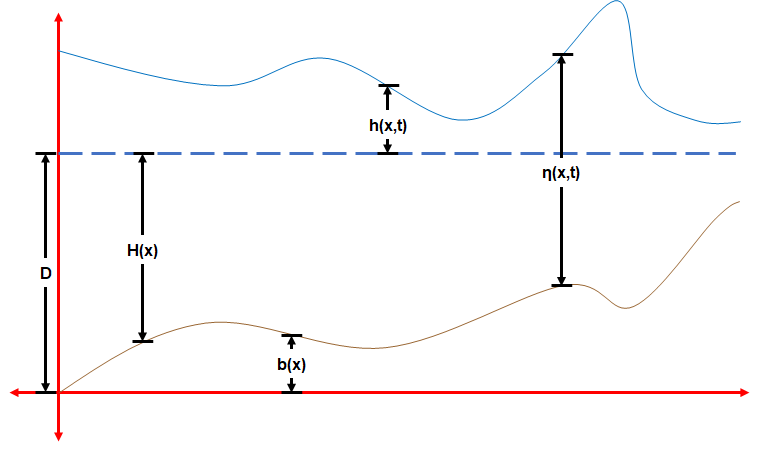|
Albert Strickler
Albert Strickler (25 July 1887 – 1 February 1963) was a Swiss mechanical engineer recognized for contributions to our understanding of hydraulic roughness in open-channel flow, open channel and pipe flow. Strickler proposed that hydraulic roughness could be characterized as a function of measurable surface roughness and described the concept of Friction loss, relative roughness, the ratio of hydraulic radius to surface roughness. He applied these concepts to the development of a Dimensional analysis, dimensionally homogeneous form of the Manning formula. Life Albert Strickler was the only child of Albert Strickler Sr. (1853–1936) and Maria Auguste Flentjen (1863–1945) of Wädenswil, Canton of Zürich, Switzerland. He was married twice, the second time as a widower. Neither marriage produced children. Strickler graduated from ETH Zurich as a mechical engineer in 1911. He earned a Ph.D. in 1917 while serving as the principal assistant to Professor Franz Prasil (1857–19 ... [...More Info...] [...Related Items...] OR: [Wikipedia] [Google] [Baidu] |
Hydraulic Roughness
Hydraulic roughness is the measure of the amount of frictional resistance water experiences when passing over land and channel features. It quantifies the impact of surface irregularities and obstructions on the flow of water. One roughness coefficient is '' Manning's n-value''. Manning's n is used extensively around the world to predict the degree of roughness in channels. The coefficient is critical in hydraulic engineering, floodplain management, and sediment transport studies. Flow velocity is strongly dependent on the resistance to flow. An increase in this n value will cause a decrease in the velocity of water flowing across a surface. Manning's n The value of Manning's n is affected by many variables. Factors like suspended load, sediment grain size, presence of bedrock or boulders in the stream channel, variations in channel width and depth, and overall sinuosity of the stream channel can all affect Manning's n value. For instance, a narrow, rocky channel with irregular ... [...More Info...] [...Related Items...] OR: [Wikipedia] [Google] [Baidu] |
1887 Births
Events January * January 11 – Louis Pasteur's anti- rabies treatment is defended in the Académie Nationale de Médecine, by Dr. Joseph Grancher. * January 20 ** The United States Senate allows the United States Navy to lease Pearl Harbor as a naval base. ** British emigrant ship '' Kapunda'' sinks after a collision off the coast of Brazil, killing 303 with only 16 survivors. * January 21 ** The Amateur Athletic Union (AAU) is formed in the United States. ** Brisbane receives a one-day rainfall of (a record for any Australian capital city). * January 24 – Battle of Dogali: Abyssinian troops defeat the Italians. * January 28 ** In a snowstorm at Fort Keogh, Montana, the largest snowflakes on record are reported. They are wide and thick. ** Construction work begins on the foundations of the Eiffel Tower in Paris, France. February * February 2 – The first Groundhog Day is observed in Punxsutawney, Pennsylvania. * February 4 – The Interstate Comme ... [...More Info...] [...Related Items...] OR: [Wikipedia] [Google] [Baidu] |
Geomorphology
Geomorphology () is the scientific study of the origin and evolution of topographic and bathymetric features generated by physical, chemical or biological processes operating at or near Earth's surface. Geomorphologists seek to understand why landscapes look the way they do, to understand landform and terrain history and dynamics and to predict changes through a combination of field observations, physical experiments and numerical modeling. Geomorphologists work within disciplines such as physical geography, geology, geodesy, engineering geology, archaeology, climatology, and geotechnical engineering. This broad base of interests contributes to many research styles and interests within the field. Overview Earth's surface is modified by a combination of surface processes that shape landscapes, and geologic processes that cause tectonic uplift and subsidence, and shape the coastal geography. Surface processes comprise the action of water, wind, ice, wildfire, and lif ... [...More Info...] [...Related Items...] OR: [Wikipedia] [Google] [Baidu] |
Sedimentology
Sedimentology encompasses the study of modern sediments such as sand, silt, and clay, and the processes that result in their formation (erosion and weathering), transport, deposition and diagenesis. Sedimentologists apply their understanding of modern processes to interpret geologic history through observations of sedimentary rocks and sedimentary structures. Sedimentary rocks cover up to 75% of the Earth's surface, record much of the Earth's history, and harbor the fossil record. Sedimentology is closely linked to stratigraphy, the study of the physical and temporal relationships between rock layers or strata. The premise that the processes affecting the earth today are the same as in the past is the basis for determining how sedimentary features in the rock record were formed. By comparing similar features today to features in the rock record—for example, by comparing modern sand dunes to dunes preserved in ancient aeolian sandstones—geologists reconstruct past environm ... [...More Info...] [...Related Items...] OR: [Wikipedia] [Google] [Baidu] |
Hydraulic Engineering
Hydraulic engineering as a sub-discipline of civil engineering is concerned with the flow and conveyance of fluids, principally water and sewage. One feature of these systems is the extensive use of gravity as the motive force to cause the movement of the fluids. This area of civil engineering is intimately related to the design of bridges, dams, channels, canals, and levees, and to both sanitary and environmental engineering. Hydraulic engineering is the application of the principles of fluid mechanics to problems dealing with the collection, storage, control, transport, regulation, measurement, and use of water.Prasuhn, Alan L. ''Fundamentals of Hydraulic Engineering''. Holt, Rinehart, and Winston: New York, 1987. Before beginning a hydraulic engineering project, one must figure out how much water is involved. The hydraulic engineer is concerned with the transport of sediment by the river, the interaction of the water with its alluvial boundary, and the occurrence of scour a ... [...More Info...] [...Related Items...] OR: [Wikipedia] [Google] [Baidu] |
Civil Engineering
Civil engineering is a regulation and licensure in engineering, professional engineering discipline that deals with the design, construction, and maintenance of the physical and naturally built environment, including public works such as roads, bridges, canals, dams, airports, sewage systems, pipelines, structural element, structural components of buildings, and railways. Civil engineering is traditionally broken into a number of sub-disciplines. It is considered the second-oldest engineering discipline after military engineering, and it is defined to distinguish non-military engineering from military engineering. Civil engineering can take place in the public sector from municipal public works departments through to federal government agencies, and in the private sector from locally based firms to Fortune Global 500, ''Fortune'' Global 500 companies. History Civil engineering as a discipline Civil engineering is the application of physical and scientific principles for solv ... [...More Info...] [...Related Items...] OR: [Wikipedia] [Google] [Baidu] |
Piping
Within industry, piping is a system of pipes used to convey fluids (liquids and gases) from one location to another. The engineering discipline of piping design studies the efficient transport of fluid. Industrial process piping (and accompanying in-line components) can be manufactured from wood, fiberglass, glass, steel, aluminum, plastic, copper, and concrete. The in-line components, known as fittings, valves, and other devices, typically sense and control the pressure, flow rate and temperature of the transmitted fluid, and usually are included in the field of piping design (or piping engineering), though the sensors and automatic controlling devices may alternatively be treated as part of instrumentation and control design. Piping systems are documented in piping and instrumentation diagrams (P&IDs). If necessary, pipes can be cleaned by the tube cleaning process. ''Piping'' sometimes refers to piping design, the detailed specification of the physical piping layo ... [...More Info...] [...Related Items...] OR: [Wikipedia] [Google] [Baidu] |
Hydrology
Hydrology () is the scientific study of the movement, distribution, and management of water on Earth and other planets, including the water cycle, water resources, and drainage basin sustainability. A practitioner of hydrology is called a hydrologist. Hydrologists are scientists studying earth science, earth or environmental science, civil engineering, civil or environmental engineering, and physical geography. Using various analytical methods and scientific techniques, they collect and analyze data to help solve water related problems such as Environmentalism, environmental preservation, natural disasters, and Water resource management, water management. Hydrology subdivides into surface water hydrology, groundwater hydrology (hydrogeology), and marine hydrology. Domains of hydrology include hydrometeorology, surface-water hydrology, surface hydrology, hydrogeology, drainage basin, drainage-basin management, and water quality. Oceanography and meteorology are not included beca ... [...More Info...] [...Related Items...] OR: [Wikipedia] [Google] [Baidu] |
Fluid Dynamics
In physics, physical chemistry and engineering, fluid dynamics is a subdiscipline of fluid mechanics that describes the flow of fluids – liquids and gases. It has several subdisciplines, including (the study of air and other gases in motion) and (the study of water and other liquids in motion). Fluid dynamics has a wide range of applications, including calculating forces and moment (physics), moments on aircraft, determining the mass flow rate of petroleum through pipeline transport, pipelines, weather forecasting, predicting weather patterns, understanding nebulae in interstellar space, understanding large scale Geophysical fluid dynamics, geophysical flows involving oceans/atmosphere and Nuclear weapon design, modelling fission weapon detonation. Fluid dynamics offers a systematic structure—which underlies these practical disciplines—that embraces empirical and semi-empirical laws derived from flow measurement and used to solve practical problems. The solution to a fl ... [...More Info...] [...Related Items...] OR: [Wikipedia] [Google] [Baidu] |
Shallow Water Equations
The shallow-water equations (SWE) are a set of hyperbolic partial differential equations (or parabolic if viscous shear is considered) that describe the flow below a pressure surface in a fluid (sometimes, but not necessarily, a free surface). The shallow-water equations in unidirectional form are also called (de) Saint-Venant equations, after Adhémar Jean Claude Barré de Saint-Venant (see the related section below). The equations are derived from depth-integrating the Navier–Stokes equations, in the case where the horizontal length scale is much greater than the vertical length scale. Under this condition, conservation of mass implies that the vertical velocity scale of the fluid is small compared to the horizontal velocity scale. It can be shown from the momentum equation that vertical pressure gradients are nearly hydrostatic, and that horizontal pressure gradients are due to the displacement of the pressure surface, implying that the horizontal velocity field i ... [...More Info...] [...Related Items...] OR: [Wikipedia] [Google] [Baidu] |
Johann Nikuradse
Johann Nikuradse ( ka, ივანე ნიკურაძე, ''Ivane Nikuradze'') (November 20, 1894 – July 18, 1979) was a Georgia-born German engineer and physicist. His brother, Alexander Nikuradse, was also a Germany-based physicist and geopolitician known for his ties with Alfred Rosenberg and for his role in saving many Georgians during World War II. He was born in Samtredia, Georgia (then part of the Kutais Governorate, Imperial Russia) and studied at Kutaisi. In 1919, through the recommendations of the conspicuous Georgian scholar Petre Melikishvili, he went abroad for further studies. The 1921 Sovietization of Georgia precluded his return to homeland and Nikuradse naturalized as a German citizen. As PhD student of Ludwig Prandtl in 1920, he later worked as a researcher at the Kaiser Wilhelm Institute for Flow Research (now the Max Planck Institute for Dynamics and Self-Organization). He succeeded in putting himself in Prandtl's favour and thus advanced to the posi ... [...More Info...] [...Related Items...] OR: [Wikipedia] [Google] [Baidu] |






